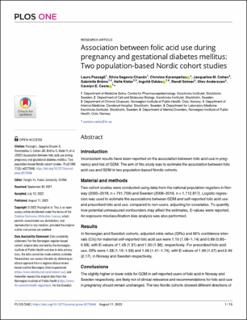| dc.description.abstract | Introduction Inconsistent results have been reported on the association between folic acid use in pregnancy and risk of GDM. The aim of this study was to estimate the association between folic acid use and GDM in two population-based Nordic cohorts. Material and methods Two cohort studies were conducted using data from the national population registers in Norway (2005–2018, n = 791,709) and Sweden (2006–2016, n = 1,112,817). Logistic regression was used to estimate the associations between GDM and self-reported folic acid use and prescribed folic acid use, compared to non-users, adjusting for covariates. To quantify how potential unmeasured confounders may affect the estimates, E-values were reported. An exposure misclassification bias analysis was also performed. Results In Norwegian and Swedish cohorts, adjusted odds ratios (ORs) and 95% confidence intervals (CIs) for maternal self-reported folic acid use were 1.10 (1.06–1.14) and 0.89 (0.85–0.93), with E-values of 1.43 (1.31) and 1.50 (1.36), respectively. For prescribed folic acid use, ORs were 1.33 (1.15–1.53) and 1.56 (1.41–1.74), with E-values of 1.99 (1.57) and 2.49 (2.17), in Norway and Sweden respectively. Conclusions The slightly higher or lower odds for GDM in self-reported users of folic acid in Norway and Sweden respectively, are likely not of clinical relevance and recommendations for folic acid use in pregnancy should remain unchanged. The two Nordic cohorts showed different directions of the association between self-reported folic acid use and GDM, but based on bias analysis, exposure misclassification is an unlikely explanation since there may still be differences in prevalence of use and residual confounding. Prescribed folic acid is used by women with specific comorbidities and co-medications, which likely underlies the higher odds for GDM. | |
